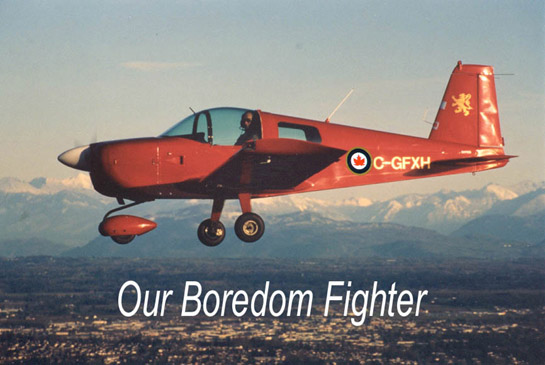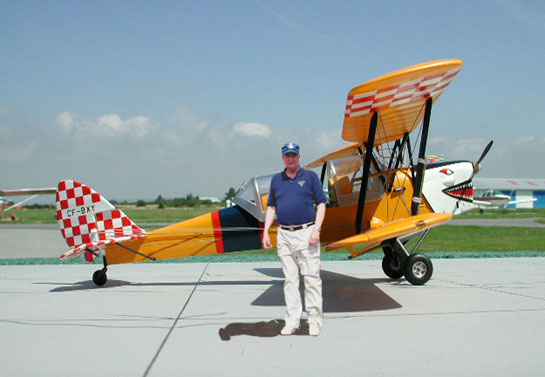Interview with Barney Dunlevy
By Barney Dunlevy
Large Scale Planes: Could you tell us a little bit about yourself please?
Barney Dunlevy: I grew up in Windsor , Ontario and started building balsa flying models during WW2. In 1949, I joined the Royal Canadian Air Cadets and by 1953 when I graduated from both high school and the cadets, I had a pilots licence and a very keen desire to be a fighter pilot. Unfortunately the jet jockey thing did not transpire so I joined the RCAF as an Air Traffic Control Assistant in Sept 1953 and for the next 23 years, I worked hard and eventually retired in 1976 as the Chief Tower Controller at CFB Moose Jaw, home of the "Snowbirds". I managed a large flying school for a few years, then got back into ATC in 1980 and I've just retired for the last time after nearly 50 years on the job.
LSP: What types of planes have you flown?
BD: Over 85 types from the 1923 DH53 Hummingbird to the CF-104D, and I now have about 4000 hours flying time. I currently own a Grumman AA1A Yankee that will be getting a "make-over" this fall.

LSP: Do you have a favorite?
BD: I think that my favourite old timer is the DH82C Tiger Moth, but then you've seen my 1/32 scale version of my old bird, so that question is a very easy one to answer…but there are different aircraft, such as the Aviat Husky on one end and the Canadair CT-114 Tutor on the other. The biggest thrill was flying with Bob Ayres in the dual CF-104.
LSP: How long have you been building models?
BD: Since about 1943
LSP: What was your first model?
BD: I can recall building a P-40 from balsa sticks and tissue paper, powered by a rubber band. The only time it flew was the last time when we added lots of lighter fluid and cotton to the nose, set it on fire and launched it from the garage roof.
LSP: How long have you been building the large scale planes and what attracted you to them?
BD: I built me first LSP about 20 years ago..the 1/24 scale series by Airfix…simply because of their size, but I soon ran out of room.
LSP: Do you prefer one medium over another?
BD: Not really. I've built radio controlled models, plastic, resin, and even carved models from blocks of wood.
LSP: Do you build other models besides planes? If so, what types?
BD: I've built old sailing ships and a few cars but my whole life has been wrapped up in aviation.
LSP: How many models would you say you've built over the years?
BD: Far too many, I really have no idea.
LSP: Do you have a stash of unbuilt models?
BD: Oh yes, but not as many as some of the guys. Probably about 200 in 1/72, 1/48, and a few in 1/32 and 1/24 scales.
LSP: What attracts you to a particular subject? Do you have a favorite era/type? Favorite manufacturer?
BD: I like doing historical research and my first love is the history of Canadian Aviation. This leads into the second part of your question, I have been going back right to the early days of flight in Canada and that is my preferred theme. To date I have over 100 models depicting Canadian aviation history. I don't have any favourite manufacturer
LSP: Do you work on more than one model at a time?
BD: Occasionally I'll have a couple on the bench but I prefer to complete a model before starting something else.
LSP: How long do you spend on a model?
BD: That depends on the quality of the kit, but I don't keep track of the time. I've reworked the Matchbox Tiger Moth and this kit will take about 100 hours to make it with the type of detail that I like. The aircraft shown here is a 1/32 scale replica of a 1/1 scale Moth that I had in the mid '50s, with me added through the good graces of Photoshop.

LSP: What's on your bench now? Are there models you like to do more than once? Any you would never touch again?
BD: I'm finishing a resin Pitts S2S "Prometheus" by Airshowmodels.com, as well as writing the construction manual for this kit. And I have a 1/48 Classic Airframes Blenheim MKIV that I am building for a friend.
There are a few; the big Tiger Moth at least 5 of them and of course Canadian operated Spitfires. One model that I would never touch again is the HiPM Henkel 100D. A beautiful aircraft, but a very bad kit. I built two of them for S/L Rod Smith of Malta fame and they were reworked so much that I could have scratch built them and saved time…but Rod loved them.
LSP: Do you have any favorite tips that you use in building?
BD: Nothing that I can think of, just the usual techniques that have been discussed many times over on this and other sites.
LSP: Do you have a preference for enamels or acrylics for the main painting job, for weathering, NMF, clear coat? Any special techniques you use?
BD: I prefer using acrylics, Polly Scale, over enamels and for weathering, I like to keep it very subtle using pastel chalks applied with a short bristle brush or Q-tip. As for NMF, I accidentally stumbled on a method that works for me when I spilled a bit of SnJ Aluminum Powder on the wing of a Classic Airframes Hudson. Initially, I had tried an Alclad II polished Aluminum finish but it did not work out so I sprayed the model with gloss black enamel intending to try the Alclad again. While the enamel was still tacky, I dropped a bit of the polishing powder on one wing and in the attempted clean-up, Smedley really messed up and he now has a full time job.
I like the Polly Scale products and therefore use their clear coats for everything.
LSP: Which airbrush and compressor, and compressor settings do you use? Do you ever brush paint?
BD: I use an old Paasche VL airbrush and a very noisy compressor. I shoot the finish at 15 psi.
LSP: Do you have a favorite filler?
BD: Good old Tamiya putty works for me
LSP: You do the instruction books for Airshow Models (Ed: I have their Pitts S2B & Bulldog), their kits are little jems. How did you get involved with them? Is there anything else you do for Airshow Models?
BD: I've known Pete Groves for a long time and when he handed me a Christen Eagle kit to build and review, I thought that it would be a great idea…but his first construction sheet was a disaster, so I offered to write up one that could be followed by any average modeler. To date, I've written five manuals and it looks like I'll be doing more.
LSP: Anything interesting coming from them you can tell us about?
BD: I'm waiting for the Pitts S2B "Double Take" and the Extra 300 prototype kits. There should be a 1/32 scale Stearman coming along later this year. It will be in both military configuration and airshow livery. And who could resist an Art Scholl Chipmunk. No date on this one but it is in the works.
LSP: Are you an IPMS member? Do you regularly attend modeling contests? If so what do you think of the future of contests?
BD: I am a member of IPMS Canada and attend the local shows and contests. I enjoy going to the various venues mainly to meet the guys that I have gotten to know over the internet and to exchange ideas. The contests have become a "who's got the deepest pockets" type of thing with all of the expensive after market products that add to the costs of a particular model. I think that we need to get back to basics and do some real modeling instead of sticking all of the goodies into a kit then claiming to have "built" it. I'll take a few flames over that one but I'd like to see more scratch building.
LSP: It doesn't seem like kids are involved in modeling like when we were kids, what do you think of the future of the hobby? What do you think of the future of our scale in the hobby for all types of kits (injected, resin, etc.) and aftermarket items?
BD: All you have to do is look at the costs of the kits these days and you'll know why there are fewer kids involved. The computer and video games also take their toll but there will always be the new guys and gals looking at our hobby and becoming hooked. We just have to be there to help them along so that they don't become discouraged. I've given away a good many kits to kids to practice on and have spent a lot of hours passing on tips on building and finishing and I get a big kick out of it.
With the computer aided manufacturing, I think that the quality of the main stream kits will improve and of course as we get older the failing eye sight tends to direct some of us to the larger scale kits. I would have difficulty building 1/72 scale models such as Len Thompson produces.
LSP: Thanks for taking the time to be interviewed!!
BD: You are welcome Brad. I guess that I am very fortunate in having a wife that loves flying as much as I do and this allows me to pursue both of my aviation hobbies. Ingrid is a licenced pilot and flies the Grumman while I get to work the camera…and I'm teaching her to work it as well. Soon I'll have to take up a new hobby.

© Large Scale Planes and Barney Dunlevy 2003
This article was published on Wednesday, July 20 2011; Last modified on Saturday, May 14 2016
